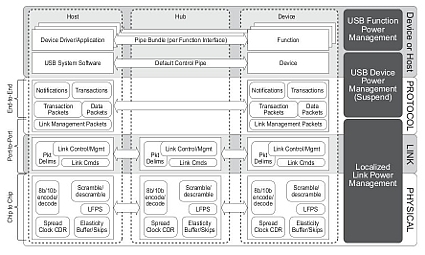SuperSpeed USB promises 5 Gbps
Last updated Dec 3, 2008 — 2136 viewsThe USB Implementers Forum has completed its development of USB 3.0, aka “SuperSpeed USB.” The new specification, offering a maximum data transfer rate ten times that of USB 2.0, is now available for download.
Despite its 10x speed hike — to 5 gigabits per second — SuperSpeed USB provides backward compatibility with USB 2.0, the USB Implementers Forum (USB-IF) claims. In contrast, USB 2.0 offered up to 480 Mbps and the original USB crawled along at 1.5 Mbps.
In addition to the speed increase, other differences between SuperSpeed USB and USB 2.0 are summarized in the following table, which appears in the USB 3.0 specification:
| Characteristic | SuperSpeed USB | USB 2.0 |
|---|---|---|
| Data Rate | SuperSpeed (5.0 Gbps) | Low-speed (1.5 Mbps), full-speed (12 Mbps); high-speed (480 Mbps) |
| Data Interface | Dual-simplex, four-wire differential signaling separate from USB 2.0 signaling; simultaneous bi-directional data flows | Half-duplex two-wire differential signaling; unidirectional data flow with negotiated directional bus transitions |
| Cable signal count | Six: four for SuperSpeed data path; two for non-SuperSpeed data path | Two: for low-speed/full-speed/high-speed data path |
| Bus transaction protocol | Host directed, asynchronous traffic flow; packet traffic is explicitly routed | Host directed, polled traffic flow; packet traffic is broadcast to all devices |
| Power management | Multi-level link power management supporting idle, sleep, and suspend states; Link-, Device-, and Function-level power management | Port-level suspend with two levels of entry/exit latency; device-level power management |
| Bus power | Same as for USB 2.0, with a 50% increase for unconfigured power and an 80% increase for configured power | Support for low/high bus-powered devices, with lower power limits for unconfigured and suspended devices |
| Port State | Port hardware detects connect events and brings the port into operational state ready for SuperSpeed data communication | Port hardware detects connect events; system software uses port commands to transition the port into an enabled state (i.e., can do USB data communication flows) |
| Data transfer types | USB 2.0 types with SuperSpeed constraints; bulk has streams capability | Four data transfer types: control, bulk, interrupt, isochronous |


The diagram below illustrates USB 3.0’s communications layers and power management architecture:
SuperSpeed USB Communications Layers and Power Management Elements
(Click image to enlarge)
Availability
First samples of SuperSpeed USB controller chips are expected to be available during the second half of 2009, with consumer products based on them following in 2010.
The first devices to incorporate SuperSpeed USB are likely to be flash drives, digital music players, and digital cameras, according to the USB-IF. “Today’s consumers are using rich media and large digital files that need to be easily and quickly transferred from PCs to devices and vice versa,” stated USB-IF chairman Jeff Ravencraft.
You can download version 1.0 of the 482-page USB 3.0 specification here (3MB zip file). Further details are available on the USB-IF’s website.


